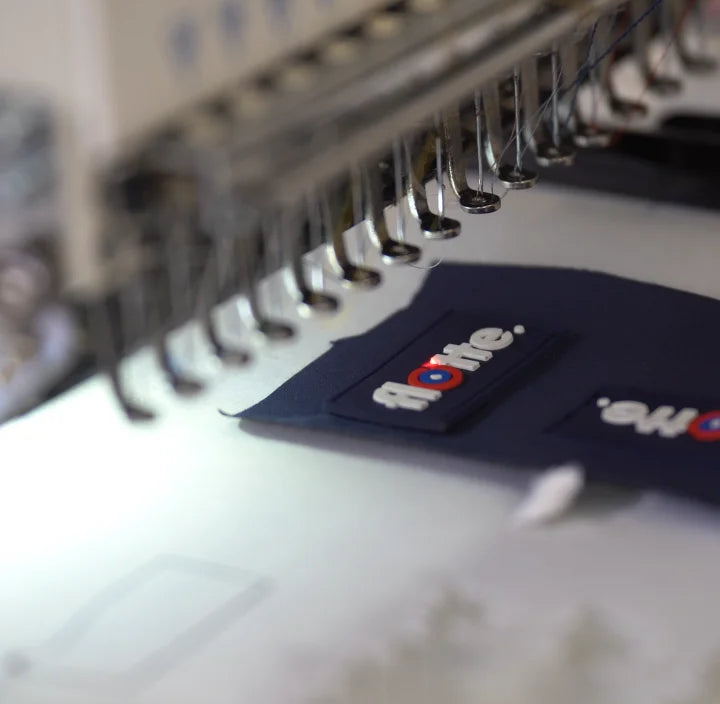Vous est-il déjà arrivé de vous retrouver sous la pluie durant plusieurs heures ? Heureusement, vous portiez un imperméable ! Mais comment celui-ci réussit-il à vous garder au sec ? Aujourd’hui, la rédac’ de Flotte vous décrypte les secrets de l’imperméabilité (ou comment vous assurer une protection de qualité !).
IMPERMÉABLE, DÉPERLANT, ÉTANCHE, C’EST QUOI LA DIFFÉRENCE ?
Pour commencer, il est important de saisir la nuance entre ces notions trop souvent confondues.
Un vêtement au tissu déperlant va agir de sorte à ce que les gouttes d’eau qui vous tombent dessus glissent tout simplement sur sa surface. Le but étant d’éviter une absorption de l’eau par le tissu et, in fine, de vous garder au sec du mieux qu’il peut.
L’imperméable agit de la même manière, à la différence près qu’il empêche également l’absorption de l’eau lorsqu’il y a stagnation ou pression sur le tissu de votre vêtement. Ce détail, qui peut paraître futile, est en réalité très important et à prendre en compte lorsque vous partez à la recherche de vêtements pour vous protéger de l’eau. En effet, un déperlant ne vous gardera pas au sec aussi longtemps qu’un imperméable puisque, sous une trop grosse pression (celle des anses d’un sac à dos par exemple), l’eau risque fortement de s’infiltrer sous le tissu et du coup, de vous mouiller ☔
Les vêtements étanches, de leur côté, sont des vêtements imperméables et dont les coutures ont été travaillées pour garder l’étanchéité de la pièce. Les coutures sont ainsi thermocollées ou soudées par ultrasons. Alors oui, étanche signifie bien que l’eau ne rentrera pas. Mais un vêtement étanche ne laissera pas non plus passer les vapeurs d’eau émises, à l’intérieur, par votre corps. Ainsi, il est fort probable que vous soyez humide sous votre veste à cause de votre propre transpiration (et non de la pluie).
Retrouvez nos collections de vestes imperméables homme et femme !
COMMENT LES VÊTEMENTS SONT-ILS IMPERMÉABILISÉS ?
Il existe deux techniques pour imperméabiliser les tissus :
L’ENDUCTION
On applique un enduit hydrofuge sur la surface interne du vêtement. Cette matière est utile parce qu’elle permet effectivement d’empêcher l’eau de pénétrer le tissu, mais aussi car elle laisse en même temps s’échapper la chaleur et l’eau produite par le corps !
Si, à premier abord, cette technique semble être une bonne solution, elle ne l’est en fait que temporairement. Les vestes ou autres produits imperméabilisés par enduction vous permettront de faire face à une pluie légère. Elles feront par exemple office de dépannage en cas de pluie surprise. Mais lors des grosses averses, ce ne seront pas les produits qui vous protégeront le plus longtemps.
En principe et généralement, la méthode de l’enduction est utilisée lorsqu’on ajoute une fonction “bonus” à un vêtement à la base destiné à une autre fonction. Un manteau par exemple est voué à tenir chaud, mais il peut aussi bien être un minimum imperméable pour être plus utile à son détenteur, plus “passe-partout”.
LA MEMBRANE
C’est un film hydrophile qui est aussi appliqué sur la face intérieure du vêtement. De cette façon, la membrane empêche l’eau de pénétrer depuis l’extérieur vers l’intérieur, mais elle permet également à toute la vapeur d’eau produite par le corps de s’échapper ! Par exemple, votre imperméable Amelot laissera à l'eau, venue de tous horizons, toute sa liberté !
Vous allez nous dire : oui donc, comme l’enduction en fait… Et bien non, la différence est que la membrane est plus durable et plus respirante, en plus d’être imperméable. Elle permet de vous garder au sec bien plus longtemps qu’avec une simple enduction, méthode avec laquelle l’enduit appliqué peut se dégrader plus rapidement au fil du temps. Vous garderez ainsi un vêtement imperméabilisé par membrane plus longtemps dans votre vie.
Cette technique est donc la plus efficace, mais cela lui vaut aussi d’être plus coûteuse que la première.
LES TESTS D’IMPERMÉABILITÉ ET L’INDICE DE SCHMERBER
Maintenant que vous connaissez tout des techniques d’imperméabilisation des vêtements, on va vous expliquer comment ça se passe pour tester l’imperméabilité. Parce que oui, rendre un tissu imperméable c’est bien, tester son efficacité et sa qualité c’est mieux !
Il existe encore une fois plusieurs techniques de vérification.
La première, c’est le test de la colonne d’eau. Ce test permet de mesurer la résistance du tissu sous la pression de l’eau. Techniquement, comment ça fonctionne ?
Le tissu imperméable est tout simplement placé sous une colonne d’eau. Celle-ci se remplit jusqu’à ce que l’eau transperce le tissu. Après ça, on peut mesurer le nombre de millimètres d’eau atteint dans la colonne au moment du transpercement du tissu, et ainsi donner le résultat et donc, l’indice d’imperméabilité.
Lorsqu’on parle de cet indice d’imperméabilité, on dit que le vêtement résiste à, par exemple, 2000 mm d’eau, ce qui équivaut à 2000 Schmerber.
Le second test est celui de la douche 🚿 Plus efficace que le premier, il permet de tester l’ensemble du vêtement. En effet, vous vous rendrez bien vite compte que si tester le tissu c’est utile et ça donne un bon indicateur de la qualité d’imperméabilité, sur une veste, on trouve aussi des parties plus exposées à l’eau, plus accessibles et plus sensibles : les zips par exemple.
Alors, tester la totalité du produit comme s’il se trouvait sous une forte pluie représente le test ultime pour connaître sa véritable résistance à l’eau. Le résultat obtenu sera en tous cas le plus fiable et le plus proche de la réalité.
Le processus est plutôt simple, le vêtement est placé sous un dispositif semblable à une douche, d’où le nom, et se fait arroser d’une grande quantité d’eau. Comme ça, il est possible de voir si l’eau s'infiltre, non seulement à travers le tissu, mais aussi à travers les coutures, les zips, et autres endroits sensibles.
Comprendre l’indice de Schmerber
Si le nom de cet indice peut sembler compliqué, c’est simplement qu’il est tiré du nom de son inventeur : Charles-Edouard Schmerber.
1 mm d’eau = 1 Schmerber 1000 schmerber = il a fallu 1 m d’eau dans la colonne avant qu’elle ne transperce le tissu
On peut considérer qu’un vêtement qui possède une résistance de 10 000 mm à l’eau vous gardera au sec durant environ une heure passée sous une bonne pluie ou sous une averse surprise. Il vous tiendra aussi au sec si une pluie fine persiste toute la journée par exemple.
Par contre, dans des conditions extrêmes, soumises à l’humidité et à la présence de beaucoup d’eau (ou si vous comptez faire Koh Lanta) préférez des vêtements et des équipements beaucoup plus techniques, allant à une résistance d’au moins 20 000 schmerber !
Rappelez-vous que l’imperméabilité est soumise aux conditions de la vie : la pression exercée sur un tissu imperméable est susceptible de réduire son efficacité ! Par exemple, comme la pression des anses d’un sac sur une veste imperméable, la pression d’un appui ou d’un objet posé sur une tente menace aussi son imperméabilité.
Et oui ! Si vous êtes un campeur avéré, vous devez sûrement déjà être au courant, mais les tentes possèdent des degrés de résistance à l’eau différents sur leur sol et leurs parois extérieures. Le tissu du sol doit être plus imperméable que les autres bords car il est quasi constamment soumis à la pression d’un matelas. Ainsi, pour s’assurer de garder un tapis de sol sec, il est important d’être attentif à ces détails-là aussi quand on part camper ⛺️
CHEZ FLOTTE, NOS IMPERMÉABLES RECYCLÉS SONT PENSÉS ET CONÇUS POUR VOUS GARDER AU SEC !
Vous l’avez bien compris, il existe de multiples méthodes pour imperméabiliser ses vêtements, mais aussi pour les tester. Et si toutes fonctionnent et ont le mérite d’exister, certaines s’avèrent être plus efficaces que d’autres ! Mais du coup, chez Flotte, qu’est-ce qu’on fait ?
> Nos matières recyclées et imperméables
Nous visons à produire une mode plus éco-responsable depuis nos débuts. Alors, si vous nous connaissez, vous n’êtes sûrement pas sans savoir que le tissu de nos imperméables est constitué à 100% de matières issues du recyclage, notamment de bouteilles en plastique recyclé, d’emballages agro-alimentaires ou encore de vêtements usés ♻️
Ce sont les principaux déchets qui constituent le rPET, la matière vers laquelle nous nous sommes tournés pour la conception de nos imperméables. Le rPET est aussi plus simplement appelé polyester recyclé.
En savoir plus sur le rPET
Ensuite, afin d’imperméabiliser nos vêtements, nous appliquons une membrane sur la surface intérieure de nos imperméables. Nous avons fait le choix de la membrane car, plus durable dans le temps, elle promettait aussi une plus grande efficacité contre l’eau et permettait à votre corps de respirer davantage qu’avec une simple enduction. Vous n’êtes bien sûr pas à l'abri de transpirer un peu en le portant longuement et sous un temps lourd, mais ça, c’est le propre de l’humain ! 💪
Nos imperméables sont tous dotés des mêmes caractéristiques :
- résistants à 10 000 mm d’eau
- respirants à 10 000 g/m²/24h
Ils sont ainsi idéals pour une utilisation dans la vie de tous les jours. En plus d'être imperméables, nos vestes sont respirantes. Mais ça veut dire quoi ?
> La respirabilité des vêtements
En fait, la respirabilité d'un vêtement, c'est sa capacité à évacuer la vapeur d'eau. Grâce à une bonne respirabilité, on évite le stockage de vapeur d'eau à l'intérieur de la veste. Cette vapeur d'eau est normale et inévitable, elle est due à la transpiration et à la différence de température entre votre corps et la température extérieure. Une bonne respirabilité est donc la clé pour être bien à l'aise dans son manteau imperméable.
> Les tests d’imperméabilité
Pour s’assurer que l’eau ne passe pas au travers de nos imperméables (auquel cas ils ne le seraient pas 😅), nous effectuons les deux tests détaillés plus haut, à savoir : le test de la colonne d’eau et celui de la douche. C’est dans un laboratoire français, à Lyon, que sont menés ces tests. Ainsi, nous faisons notre possible pour connaître au mieux la résistance à l’eau de nos vêtements à travers des tests, à la fois sur le tissu principal, et sur le vêtement en entier.
Le test de la colonne d’eau nous permet, dans un premier temps, de nous assurer de l’imperméabilité de notre tissu. Et celui de la douche nous garantit, ensuite, une imperméabilité totale.
Plot twist : nos imperméables sont imperméables. Ils résistent à une pression de 10 000 mm d’eau et sont respirants, de quoi être prêt à affronter une averse ou une journée entière de fine pluie ! Alors, si vous cherchez le parfait compagnon pour vos aventures (quotidiennes ou un peu folles), nos imperméables colorés et recyclés sont faits pour vous !
PS : Après avoir lu cet article, vous pourrez aussi vous vanter de tout savoir sur l’imperméabilité 🌈

























Bonsoir,
Est-ce que vos doudounes sont étanches à 10 000 mm d’eau aussi ?
Merci !
Laissez un commentaire